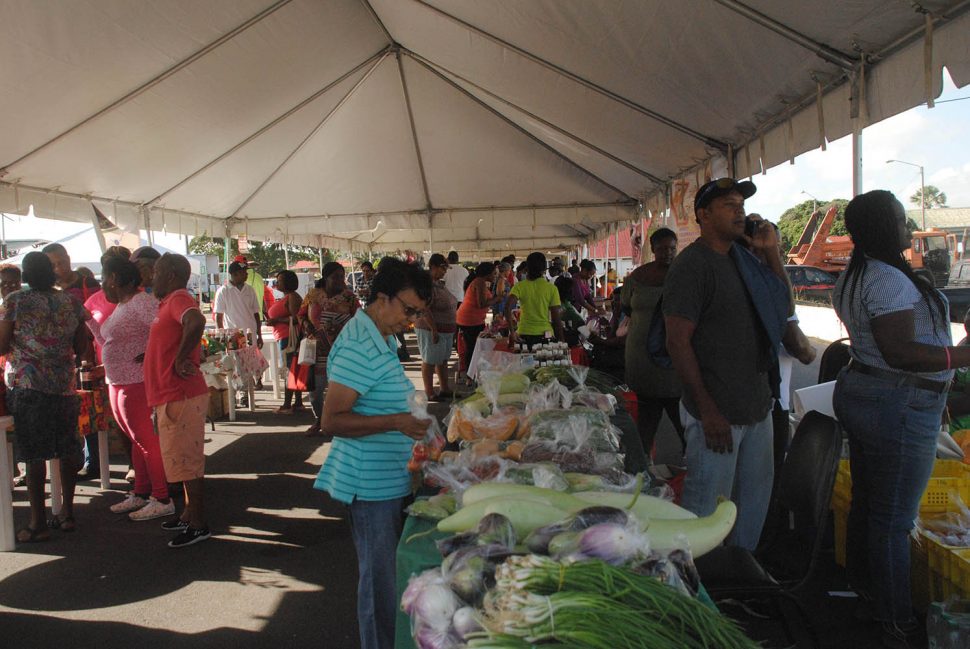For all the challenges that continue to be associated with finding adequate local markets for the volumes of fruit and vegetables produced by local farmers, the New Guyana Marketing Corporation (GMC) continues to undertake periodic initiatives to bring buyers and sellers from the coastal regions together.
Considerations of distance and high travel costs, however, limit the frequency with which farm produce and agro-processed goods from hinterland communities find their way to markets in the capital.
Aware that the festive season customarily generates an increased demand for agricultural produce, the GMC last Saturday staged a Christmas Market. While organisational constraints would have placed limits on the number of vendors invited to participate in the event, Stabroek Business learnt that farmers and agro-producers from Regions One, Two, Three, Four, Five and Six were invited to bring their produce ‘to market.’
From as early as around 5:30am, vendors and shoppers began to congregate at D’Urban Park to get the best of the bargains brought in from the various regions. The GMC could not have been more pleased with the response by the farmers and agro-processors. Figures provided by the Corporation’s Robb Street office indicated that 53 of the 60 vendors invited to participate in the event, showed up
At the same time, the turnout by buyers suggested that many of them may have taken the day off from their customary municipal market jaunt not just to redirect their patronage, even if temporarily, but also to secure a more refined understanding of the scope of the country’s agricultural sector..
With events like UNCAPPED and GUYTIE having provided valuable platforms for the agro-processing sectors during the course of 2018, 33 of the 53 vendors who participated in the Christmas Market were from the agro-processing sector. On Saturday, they paraded their ever-widening range of food spices and condiments, many of them providing manifest evidence of having long gotten over the challenges associated with packaging and labeling.
Additionally, five farmers, four plant vendors, four meat vendors, two craft vendors and three food vendors participated in the event. Two state-run agencies, the National Agricultural Research & Extension Institute and the Guyana School of Agriculture, as well as the privately-owned Sterling Products, also put in an appearance.
The range of items brought to market on Saturday reflected both the traditional items that are common to the agro-processing industry including casareep and pepper sauce while locally manufactured ham and preserved fruit were among the concessions to Christmas cooking. Fresh fruit and vegetables, porridge mixes, flour and coconut oils helped to round out the items available at the market. The presence of locally cultivated onions at the market pointed, perhaps, to greater volumes appearing on the market in the new year.
Long before the scheduled midday close of the Christmas Market, some of the vendors had ‘closed shop,’ seemingly satisfied with the day’s takings but making the point to the Stabroek Business that these opportunities don’t come often enough. This, they concede, has to do mostly with the fact that it is sometimes challenging to meet the cost of bringing larger quantities of goods to market. “Maybe we can plan a bit better,” volunteered one vendor. We were unsure as to whether she was directing her comment towards the GMC or whether it was simply an introspective comment. She said that finding markets is becoming increasingly competitive in the rural agricultural communities and that, perhaps, if there could be more ‘market’ days, that might encourage increased production.
Markedly absent from the Christmas Market was any meaningful representation of hinterland produce. Over the years, we simply have not been able to make much headway in persistently moving volumes of Amerindian agricultural produce and agro-processed goods to coastal markets. It is one of the challenges that still limits the success of the sector.






